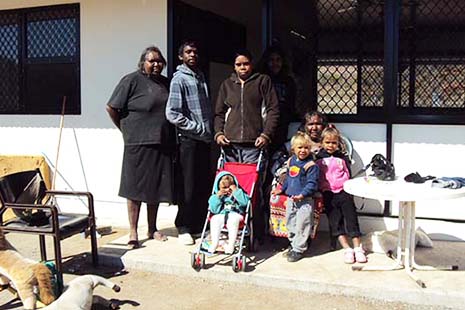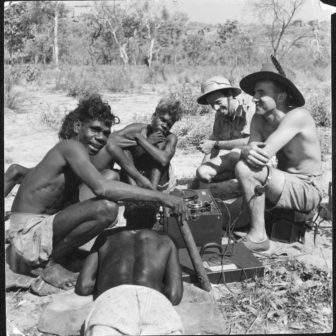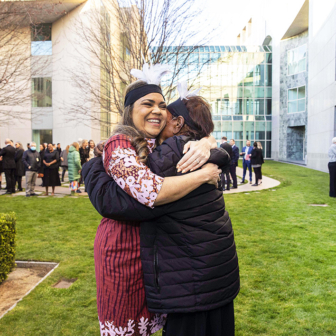“I’LL BE happy with a tin shed, small one, with a lock.” A pensioner in his seventies expressed this modest wish when I visited his informal camp in Alice Springs a year ago. Not everyone wants the suburban dream or institutionalised neatness of the federal and NT governments’ normalisation plans for town camps. The man was squatting with relatives on a strip of vacant land between Charles Creek and Hoppy’s town camps. He had a house in his home community of Papunya, some 200 kilometres to the west, but after the death of his wife and son he no longer wanted to live there. The company of family members in town was more important than a house, and in any case he mostly preferred the sun and stars over his head, with a tarp on hand for the relatively rare rains. His sole need for a structure was to secure his few belongings, including food.
Some of the people squatting with him had been returning to the site on and off for years. Like him they all had access to housing in their Western Desert communities, but promise of a quick return on their artwork brought them regularly into town. I’d first met the group in December 2007. They were getting ready to go home for the summer but not until they’d enjoyed a Christmas dinner put on for them by one of their clients. Whatever this man’s motives, he offered something they wanted – immediate cash and cars in return for their paintings, and a kind of friendship.
Their camp was the stuff of shock-horror TV news stories: scattered swags and dirty blankets; strewn with rubbish including great drifts of green cans (VB beer); the inevitable dogs, and a milk crate hooked in the branches of a tree to keep food out of their reach. I can’t say these people seemed unhappy. The then fairly fresh measures of the federal government’s Intervention sat with them lightly. They were all still accessing their full Centrelink payments; they thought that income quarantining would catch up with them eventually but didn’t really mind – it would be a way of saving money for food. They laughed about police efforts to enforce the new ban on drinking in town camps (now being wound back). They’d hide their grog in the hills or in the long grass around the camp and wait till the police Toyota came past at 3 pm, regular as clockwork; or they’d take it cross-country to the Old Telegraph Station where public drinking is not outlawed. They weren’t hardened drinkers, but drank regularly when they were in town. It was just part of town life. At home they preferred to look for pituri (bush tobacco) and hunt for kangaroos and goannas.
Of course not everyone copes as well in these precarious conditions. Not far from this camp, a few months later, I met a woman camped under a tree in the dry creekbed, with two other women and a couple of dogs for protection. She had left a house at Old Timers town camp because her husband had died there (custom has it that family members must move away from their abode after a death). She had a mattress in the shade, blankets and food stashed in the tree. If she had to leave the camp unattended, she would bury the food or it would be gone on her return. She seemed sad and very vulnerable.
I tell you these stories to put human faces on the situation I am discussing, and also to make a point about the variety of human circumstances and choices that will continue to test the best “normalising” efforts of governments and planners. They are just some of the people who swell the population of Alice’s town camps from around 2000 to well over 3000 at certain times of the year. They may come as visitors but the average length of stay is three months, and many stay for years. The old man first mentioned had been living in Alice for five years when I met him. They are part of the “urban drift turned tidal wave” to which a taskforce convened by then NT local government and housing minister Elliot McAdam drew attention in early 2006. A couple of months later, then federal Indigenous affairs minister Mal Brough staged a joint press conference with the then chief minister, Clare Martin, to announce that managed camping sites and hostels would be built “in the immediate term” to relieve pressure on town camps. “Immediate” was a Mal Brough kind of word, and he quickly provided disused dongas from the Woomera Detention Centre to solve what he rightly saw as a crisis. The dongas caused a furore in town and were ultimately shipped to bush communities, and Brough was out of his portfolio and the parliament long before his “crash or crash through” style could have a real impact on the peculiar combination of complexity, complacency and inertia that means everything happens slowly in the Territory.
Five years later the promised “managed camping sites” have become one site, the Apmere Mwerre Visitor Park, located where the Aboriginal social club used to be, right next to the RSPCA animal shelter, south of Heavitree Gap. It was officially opened on 2 February this year, with politicians aplenty in attendance, but it was some weeks before it actually received its first clients. It can cater for 150, with a range of accommodation options, including camping with your own swag for just $5 a night (no charge for children). There are also tents and self-contained cabins. A dining room provides meals for an unbeatable $32 a week or guests can cook their own food on barbecues. It is grog and drug free. The park is managed by Aboriginal Hostels, well-reputed for its other facilities around town. Money for the park came from the federal government’s $150 million Alice Springs Transformation Plan, formulated by Labor’s Indigenous affairs minister Jenny Macklin to continue, more or less, what Brough had started in Alice. By way of temporary accommodation, the plan has also funded eight new rooms at the Salvation Army Men’s hostel, opened on 11 February; a seventy-nine-bed “transitional housing” facility at Percy Court; and the thirty-five-bed refurbished accommodation known as The Lodge, formerly for single men, now an additional facility for people in Alice Springs for short-term medical treatment. In all, these facilities cater for 272 people, a long way from meeting the total need but certainly an improvement.
Percy Court is different from the others, in that it caters for residents or would-be residents rather than for visitors. They’ll be people eligible for public housing and either homeless or at risk of homelessness, this risk arising particularly because they’ve had “difficulty maintaining a tenancy.” Mission Australia has won the tender to run it and it should start receiving its first tenants in June. Over half of the twenty-nine units are one-bedroom but there are also three- and four-bedroom houses for families. There are substantial common areas, including meeting rooms, a playground, and firepits and barbecues. The tenants will be “supported” to learn how to live responsibly in rented accommodation. You would have to have seen the state of some (not all) of the public housing around town, in the camps and in the suburbs – black with grime, vermin-infested, blocked toilets, exposed electrics, mounds of rubbish, broken windows and doors, broken everything – to appreciate how useful this particular project will be, if it works.
A challenge for Percy Court may well be where its tenants will go once they “graduate.” The waiting list for public housing is desperately long – more than three years for a one-bedroom flat, nearly five years for a three-bedroom home. New housing in the town camps may soak up some of the need: eighty-five houses are supposed to be built, eighteen have been completed and thirty-one are under way; thirty-nine “rebuild and refurbishments” have also been completed and fourteen more are under way.
I visited one of the new houses at Hidden Valley town camp last August. Before the Intervention, I, like everyone else including Town Council staff, would have had to seek permission for this visit from Tangentyere Council, the service-delivery body for the camps. It most likely would have been refused. They once threatened me with legal action for trespass for having had the temerity to visit a Hidden Valley resident to talk about the impact of grog in the camp. One good thing about “normalisation” is that you can now visit town camp residents as you would anyone else – speaking to them directly to ask to be received, going away if declined. I don’t say this as a matter of convenience for a journalist, but as a matter of simple human relationships.
The house I visited had been allocated to an elderly dialysis patient who until then had been sharing another house with twelve adults and five or six small children, with no-one taking responsibility to keep it clean. Her nephew told me that that was “stressing her out.” In the new house she was living with two adult grandchildren and eight young children. Luckily, she loved little kids – “They make me happy, they’ve got to stop here with me” – and the house had four bedrooms and two bathrooms. It was simple but roomy and robust. There were no verandahs, but the yard at the back was large enough, and on a cold, windy day it was sunny and sheltered. The old woman and her daughter, who was visiting, told me that Territory Housing, which now manages town camp housing, once the province of Tangentyere, regularly dropped in to see if they were keeping the house clean. They didn’t seem to mind. “Before they come we clean the floor, we clean all the walls. If kids chuck ice cream or whatever on it, we got to clean it. If they see it’s dirty, we have to get out from this house, go back and stop at another house,” said the daughter.
The old woman said she lived off the money on her Basics Card – 50 per cent of her pension – saving the rest to buy the kids a treat from the mobile shop doing the rounds after school. She, her daughter and her nephew were all happy enough with the Basics Card, one of the enduring features of Brough’s Intervention, which sees half of Centrelink income quarantined for essentials like food and rent and accessed via this card. It is detested by some as oppressive paternalism, but “Basics Card is all right,” said the daughter. “Before people spent their money on grog and cards, now we buy tucker, clothes.”
All this casts the Intervention in a fairly successful light, but further comments from the old woman point to a problem that it is yet to address, indeed that it fosters, and that is passivity together with an unrealistic sense of entitlement. The old woman was really very happy with her new house but as she and her daughter showed me the kitchen, which came fitted out with stove, fridge and stainless steel benches, she complained that the government had not given her a washing machine. She also wanted a fire-bin (I suggested trying the Tip Shop) and pointed to an adjacent site, expressing the wish that the government build a house there for her daughter (who already has a house elsewhere).
As I went back to my car, her nephew walked with me. Wheelie bins were lined up for rubbish collection, a novel sight in a town camp, and I remarked on it. The nephew expressed his satisfaction with the new system: “Step by little step” things are improving, he said. Before the Intervention, rubbish – when it wasn’t left strewn across the ground – was put in forty-four-gallon drums. They couldn’t easily be moved and dogs used to jump inside, scattering litter everywhere. When they were full, the rubbish was often set alight, creating a noxious pall over the camps. Residents frequently claimed that collection, undertaken by Tangentyere Council, was sporadic.
Tangentyere had signed a Memorandum of Understanding with the Alice Springs Town Council in late 2000, which allowed it to take over delivery of municipal services. The expressed rationale for Tangentyere’s wanting to do this was to provide employment for Aboriginal people. For the Town Council it was, in the words of its then CEO, a move to secure a future “for our children [that] they deserve.” Within a few years these words had a resoundingly hollow ring, as the camps began to drown in a sea of rubbish and the MOU was shown up for the abdication of responsibility that it was (although a problem for the Town Council was that town camps were exempt from rates). Under the Transformation Plan the Town Council has been funded to resume municipal services to the camps, including a dog-control program.
Rubbish collection, dog control – they are things most of us take for granted and are relatively simple for local governments in affluent Australia to deliver. In the town camps of Alice Springs they are, at least, an undeniable improvement. Big problems remain, the most pressing being alcohol abuse and violence fuelled by idleness, and the future of the children growing up inside this chaos. In a second article I’ll discuss what progress is being made on these fronts. •




